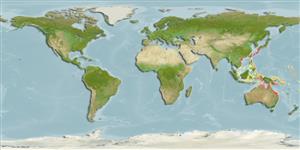>
Ovalentaria/misc (Various families in series Ovalentaria) >
Pomacentridae (Damselfishes) > Microspathodontinae
Etymology: Parma: Latin, parma, -ae = a little shield.
More on author: Whitley.
Environment: milieu / climate zone / depth range / distribution range
Ecologia
marinhas associadas(os) a recifes; não migratória; intervalo de profundidade 2 - 20 m (Ref. 7247). Tropical
Western Pacific: eastern Australia between Cape Tribulation, Queensland and Sydney, New South Wales.
Tamanho / Peso / Idade
Maturity: Lm ? range ? - ? cm
Max length : 16.5 cm SL macho/indeterminado; (Ref. 7247)
Descrição breve
Morfologia | Morfometria
Espinhos dorsais (total): 2; Raios dorsais moles (total): 17-20; Espinhos anais 2; Raios anais moles: 13 - 15
Museum specimens indicate that this species is probably most abundant in non-coral reef coastal waters, although one specimen at the Australian Museum was taken at Great Island on the Great Barrier Reef, Australia. Life history characteristics for the family specify that this group is oviparous, with distinct pairing during breeding (Ref. 205). Eggs are demersal and adhere to the substrate (Ref. 205). Males guard and aerate the eggs (Ref. 205). Diurnal species (Ref. 113699).
Life cycle and mating behavior
Maturidade | Reprodução | Desova | Ovos | Fecundidade | Larvas
Life history characteristics for the family specify that this group is oviparous, with distinct pairing during breeding (Ref. 205). Eggs are demersal and adhere to the substrate (Ref. 205). Males guard and aerate the eggs (Ref. 205).
Allen, G.R., 1991. Damselfishes of the world. Mergus Publishers, Melle, Germany. 271 p. (Ref. 7247)
Categoria na Lista Vermelha da IUCN (Ref. 130435)
Ameaça para o homem
Harmless
Utilização humana
Mais informação
Idade/TamanhoCrescimentoComprimento-pesoComprimento-comprimentoFrequência de comprimentoMorfometriaMorfologiaLarvasDinâmica larvarRecrutamentoAbundânciaBRUVS
ReferênciasAquaculturaPerfil para aquaculturaEstirpesGenéticaElectrophoresesHereditariedadeDoençasProcessamentoNutrientsMass conversion
Ferramentas
Relatórios especiais
Descarregue XML
Fontes da internet
Estimates based on models
Preferred temperature (Ref.
123201): 24.3 - 28.2, mean 26.9 °C (based on 680 cells).
Phylogenetic diversity index (Ref.
82804): PD
50 = 0.5010 [Uniqueness, from 0.5 = low to 2.0 = high].
Bayesian length-weight: a=0.01950 (0.00922 - 0.04124), b=3.00 (2.82 - 3.18), in cm total length, based on LWR estimates for this (Sub)family-body shape (Ref.
93245).
Nível Trófico (Ref.
69278): 2.7 ±0.24 se; based on food items.
Resiliência (Ref.
120179): Médio, tempo mínimo de duplicação da população 1,4 - 4,4 anos (Preliminary K or Fecundity.).
Fishing Vulnerability (Ref.
59153): Low vulnerability (10 of 100).
Nutrients (Ref.
124155): Calcium = 81.5 [41.5, 129.3] mg/100g; Iron = 0.655 [0.404, 1.069] mg/100g; Protein = 18.2 [17.1, 19.4] %; Omega3 = 0.101 [0.063, 0.161] g/100g; Selenium = 23.1 [13.1, 42.9] μg/100g; VitaminA = 83.2 [22.9, 279.6] μg/100g; Zinc = 1.59 [1.10, 2.29] mg/100g (wet weight);
